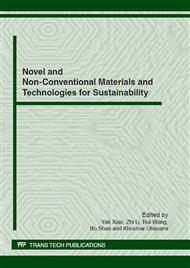p.3
p.13
p.20
p.27
p.34
p.43
p.51
p.63
Impregnation of Bambusa Vulgaris with Polymeric Resins
Abstract:
There are more than one thousand of bamboo species around the world, but in some areas the most common is the Bambusa vulgaris. Comparing with other species used in construction, it is more susceptible to insect attack and its strength is slower. This work shows some studies made using culms of this bamboo with the aim to improve its durability and mechanical properties by impregnation of polymeric resins into their vases. Some information about Bambusa vulgaris microstructure is done. The percentage of vases, fibers and parenchyma was measured using an optical microscope. The absorption of this species in liquids with different viscosities was determined. Using an equipment to force the liquid into the vases, time of penetration of fluids with different viscosity was measured. Results show that the fluids penetrate most easily in the internal vases, where the diameter is greater than that close to external face of the culms and confirm that it is possible to fill the bamboo vases with viscous fluid as oil or polymeric resins. The attack of insect was eliminated when a impregnation with a resin made by 80 % de styrene + 20 % de metilmetacriyate was applied to Bambusa vulgaris culms.
Info:
Periodical:
Pages:
27-33
Citation:
Online since:
June 2012
Keywords:
Price:
Сopyright:
© 2012 Trans Tech Publications Ltd. All Rights Reserved
Share:
Citation:


